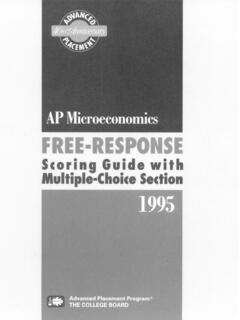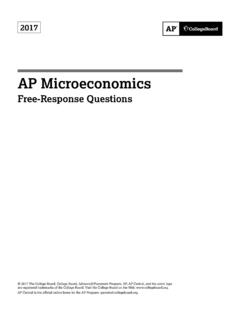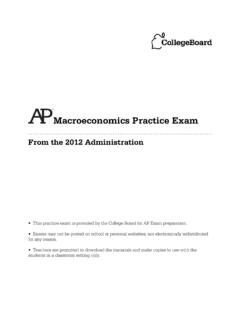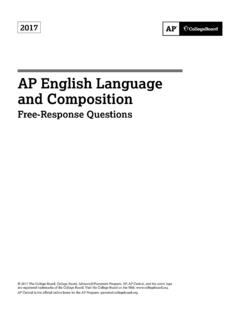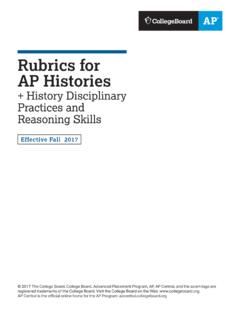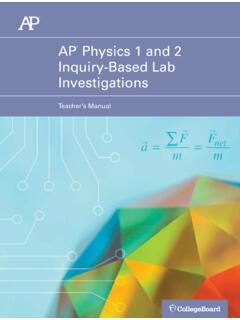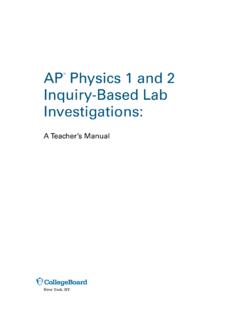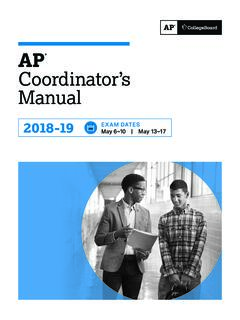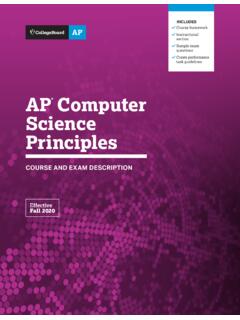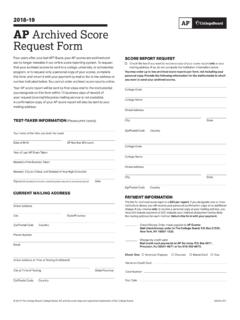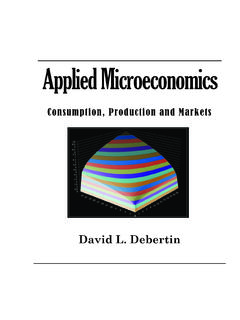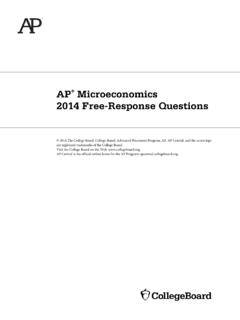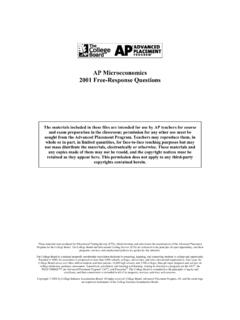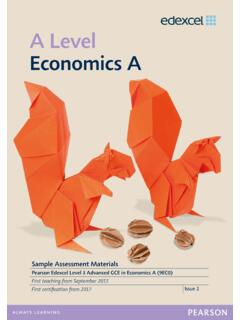Transcription of AP Microeconomics 2019 Free-Response Questions: Set 1
1 2019 AP MicroeconomicsFree-Response QuestionsSet 1 2019 The College Board. College Board, Advanced Placement, AP, AP Central, and the acorn logo are registered trademarks of the College Board. Visit the College Board on the web: AP Central is the official online home for the AP Program: 2019 AP Microeconomics Free-Response QUESTIONS Microeconomics section II Total Time 1 hour Reading Period 10 minutes Writing Period 50 minutes Directions: You are advised to spend the first 10 minutes reading all of the questions and planning your answers. You will then have 50 minutes to answer all three of the following questions. You may begin writing your responses before the reading period is is suggested that you spend approximately half your time on the first question and divide the remaining time equally between the next two questions.
2 Include correctly labeled diagrams, if useful or required, in explaining your answers. A correctly labeled diagram must have all axes and curves clearly labeled and must show directional changes. Use a pen with black or dark blue ink. 1. As the only gas station in a small town, FillUp has a local monopoly on the sale of gasoline. FillUp is currently earning positive economic profit. (a) Draw a correctly labeled graph for FillUp and show each of the following. (i) FillUp s profit-maximizing quantity, labeled QF (ii) FillUp s profit-maximizing price, labeled PF (iii) The deadweight loss associated with FillUp s profit-maximizing quantity, shaded completely (iv) The maximum quantity at which FillUp would earn zero economic profit, labeled QZ (b) Assume that FillUp s fixed costs increase because of a new lease on its property and FillUp stays in business.
3 Will each of the following increase, decrease, or remain unchanged at FillUp s profit-maximizing quantity? (i) The deadweight loss. Explain. (ii) FillUp s economic profit (c) Assume the demand for gasoline decreases because people bike to work more often. (i) What must be true for FillUp to continue to operate in the short run? (ii) What happens to FillUp s profit-maximizing quantity and price in the short run assuming the firm continues to operate? GO ON TO THE NEXT PAGE. -2- 2019 The College Board. Visit the College Board on the web: 2. The following is a table showing Dana s marginal benefit from purchasing bottles of water and good X from agrocery store. 2019 AP Microeconomics Free-Response QUESTIONS Quantity of Water (in bottles) Marginal Benefit of Water (in dollars) 1242183124653 Quantity of Good X (in units) Marginal Benefit of Good X (in dollars) 1242183124653(a)What is Dana s total benefit from purchasing 2 bottles of water and 1 unit of good X?
4 Show your work.(b)Assume the price of a unit of good X is $5. Calculate the total consumer surplus if Dana purchases 3 units ofgood X. Show your work. (c)Now assume the price of a bottle of water is $3 and the price of a unit of good X is $6. Dana spends herentire budget of $30 on bottles of water and good X. (i)Explain why Dana does not maximize her benefit when she purchases 2 bottles of water and 4 units of good X. Use marginal analysis to explain your answer.(ii)What are the optimal quantities of good X and bottles of water at these prices? (iii)Suppose the price of a unit of good X drops to $3. Calculate Dana s cross-price elasticity of demandfor bottles of water with respect to the price of good X, and state whether the two goods are substitutesor complements. Show your work. GO ON TO THE NEXT PAGE.
5 -3- 2019 The College Board. Visit the College Board on the web: Dee s PizzeriaEnter Stay Out Advertise Patrick s Pie Do Not Advertise $50, $2 $175, $0 $150, $15 $100, $0 s Pie is currently the only pizzeria in College Town. It can either advertise or not advertise. Dee sPizzeria is contemplating whether to enter or stay out of the College Town market. Each pizza establishmentindependently and simultaneously makes its decision. The payoff matrix above shows the profits for eachcombination of decisions, and both players have complete information. The first entries in the payoff matrix arePatrick s profit, and the second entries are Dee s profit. 2019 AP Microeconomics Free-Response QUESTIONS (a)What actions maximize the combined total profits for Patrick s Pie and Dee s Pizzeria?
6 (b)Conditional on your response in part (a), does either Patrick s Pie or Dee s Pizzeria have an incentive tocheat on this combination of actions that maximize the combined total profits? Explain using numbers fromthe matrix for each pizzeria.(c) Does Patrick s Pie have a dominant strategy?(d)Identify the Nash equilibrium or equilibria actions for this game.(e)Ignoring antitrust considerations, suppose that Patrick pays Dee s Pizzeria $20 if Dee chooses to Stay Out. (i)Redraw this matrix including players, actions, and payoffs, showing how Patrick s Pie payment to Deeaffected the payoffs.(ii)Identify the Nash equilibrium for the redrawn END OF EXAM -4- 2019 The College Board. Visit the College Board on the web.
